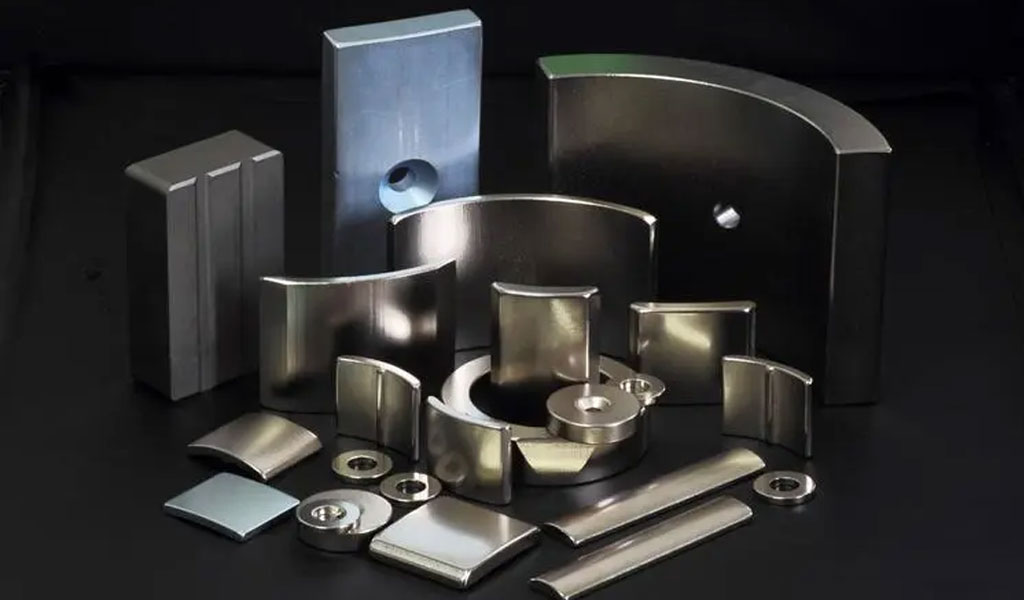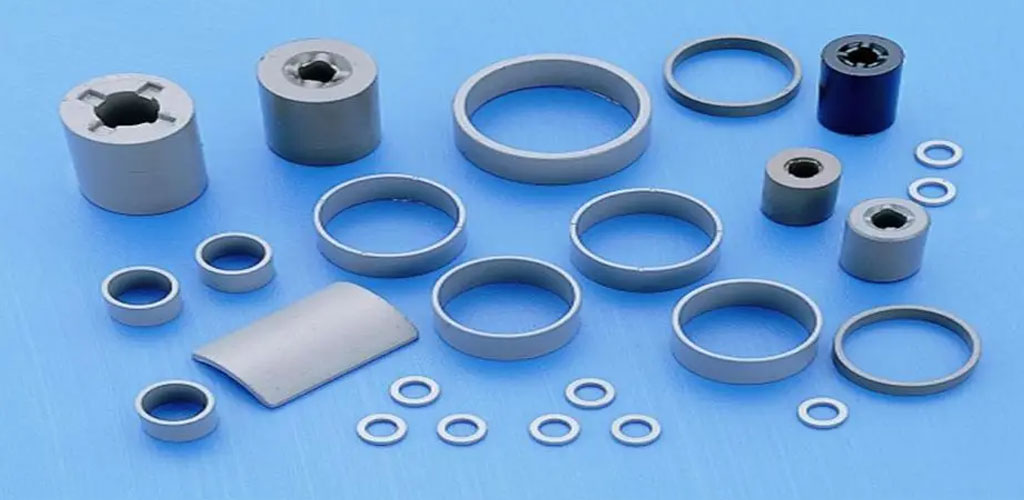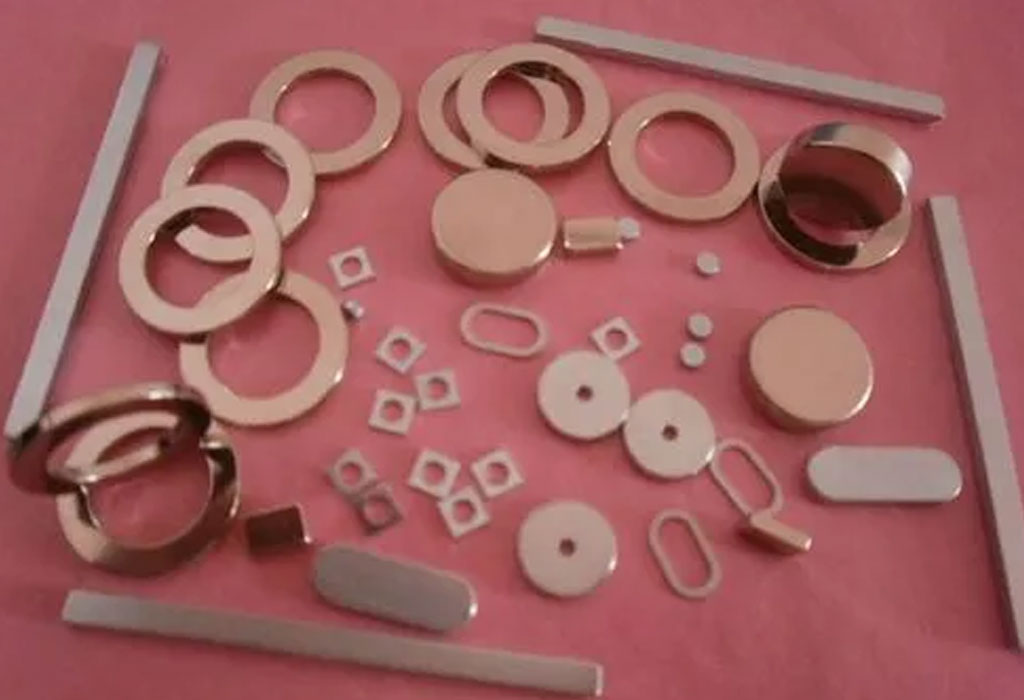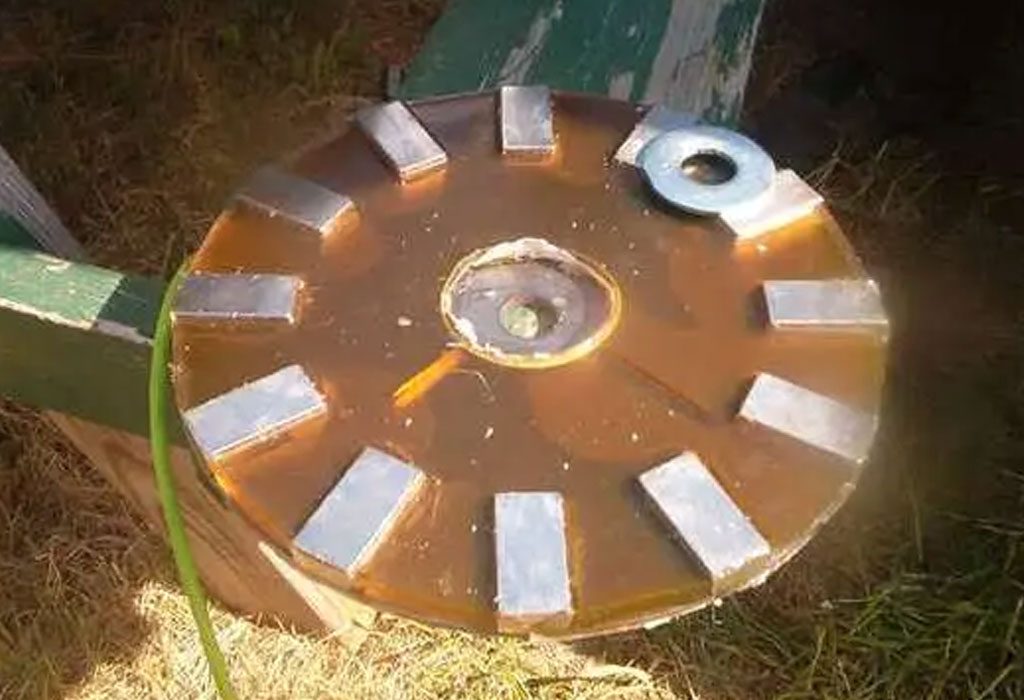One of the most pivotal innovations in recent decades has been the development and utilization of neodymium iron boron (NdFeB) magnets. These small yet mighty magnets have revolutionized various industries, from electronics and automotive to renewable energy and healthcare.
Rare earth permanent magnet material is a magnetic material made from an alloy composed of samarium and neodymium mixed rare earth metals and transition metals (such as cobalt, iron, etc.), pressed and sintered using powder metallurgy methods, and magnetized by a magnetic field
Rare earth permanent magnets are divided into samarium cobalt (SmCo) permanent magnets and neodymium iron boron (NdFeB) permanent magnets. The magnetic energy product of SmCo magnets is between 15-30 MGOe, and the magnetic energy product of NdFeB permanent magnets is between 27-50 MGOe. Known as the “King of Permanent Magnets”, it is currently the most magnetic permanent magnet material.
This article will discuss the composition of NdFeB, its characteristics, material properties, and applications.

What Is Neodymium Iron Boron (NdFeB) Magnets
Neodymium iron boron (NdFeB) magnets, also known as neodymium magnets or Nd magnets, are a type of permanent magnet made from an alloy of neodymium, iron, and boron. They are renowned for their exceptional magnetic properties, including high magnetic strength, coercivity, and remanence. NdFeB magnets are widely regarded as the strongest type of permanent magnets available commercially, surpassing traditional magnets such as ferrite or alnico in terms of magnetic energy density.
These magnets owe their remarkable properties to the unique combination of elements in their composition. Neodymium, a rare earth element, contributes to the magnets’ high magnetic strength, while iron provides stability and boron enhances coercivity, allowing the magnets to maintain their magnetization over extended periods.
NdFeB magnets are typically produced through a multi-step manufacturing process, which includes melting the raw materials, milling them into powder, pressing the powder into the desired shape, sintering at high temperatures, and finally, machining the magnets to precise specifications. This intricate production process is essential for achieving the desired magnetic properties and shape of the final product.
Due to their compact size and exceptional magnetic strength, NdFeB magnets find widespread use across various industries and applications. They are commonly employed in electronics, automotive components, renewable energy systems, medical devices, industrial machinery, and consumer products. Examples of their applications include smartphone speakers, electric vehicle motors, wind turbine generators, MRI machines, magnetic separators, and more.
The Alloy Composition of NdFeB magnets
The alloy composition of neodymium iron boron (NdFeB) magnets consists primarily of three elements: neodymium (Nd), iron (Fe), and boron (B). These elements are combined in precise proportions to create a crystalline structure with exceptional magnetic properties. In addition to the primary elements, NdFeB magnets may also contain small amounts of other elements, such as dysprosium (Dy), praseodymium (Pr), and terbium (Tb), which are added to enhance certain properties or mitigate issues such as magnetic instability at elevated temperatures.
The typical alloy composition of NdFeB magnets is as follows:

- Neodymium (Nd): Neodymium is a rare earth element that contributes significantly to the magnetic strength of NdFeB magnets. It is often the most abundant rare earth element in the composition, typically ranging from around 30% to 35%.
- Iron (Fe): Iron serves as a stabilizing element in the alloy, helping to maintain the structural integrity of the magnets. It constitutes a significant portion of the composition, usually ranging from about 60% to 65%.
- Boron (B): Boron is a crucial component that enhances the coercivity of NdFeB magnets, allowing them to maintain their magnetization in the presence of external magnetic fields. Boron content typically falls between 1% to 1.5%.
In addition to these primary elements, NdFeB magnets may also contain small amounts (often less than 5% by weight) of other elements, such as dysprosium, praseodymium, and terbium. These elements are added in precise amounts to tailor the magnetic properties of the magnets for specific applications. For example, dysprosium is commonly added to improve the magnets’ thermal stability and resistance to demagnetization at high temperatures.
The Different Types of NdFeB magnets
NdFeB magnets can be divided into two types: bonded NdFeB and sintered NdFeB. Bonding is actually injection molding, while sintering is vacuum molding through high-temperature heating. These types are categorized based on their composition, microstructure, and manufacturing process. Below are the main types of NdFeB magnets:
1.Sintered NdFeB Magnets
Sintered NdFeB magnets are produced through a powder metallurgy process involving the sintering of NdFeB magnetic powder under high pressure and temperature.
This type of magnet offers the highest magnetic energy product (BHmax) and is known for its exceptional magnetic strength and stability.
Sintered NdFeB magnets are available in various grades, ranging from low to high coercivity and remanence, to meet different performance requirements.
2.Bonded NdFeB Magnets
Bonded NdFeB magnets are manufactured by mixing NdFeB magnetic powder with a polymer binder, such as epoxy or nylon, and then compression molding, injection molding, extrusion bonding, or calendaring the mixture into the desired shape.
This type of magnet offers flexibility in shape and size, as well as isotropic or anisotropic magnetic properties.
Bonded NdFeB magnets are often used in applications requiring complex shapes, close tolerances, or magnetic assemblies.
3.Hydrogen Decrepitation (HD) Processed Magnets
HD processed NdFeB magnets are produced using a specialized manufacturing process called hydrogen decrepitation, which involves milling and annealing NdFeB alloy in a hydrogen atmosphere.
This process results in improved magnetic properties, particularly in terms of coercivity and remanence, compared to conventional sintered magnets.
HD processed magnets are used in applications requiring high coercivity and stability, such as high-performance motors and sensors.
4.Hot Deformation Magnets
Hot deformation NdFeB magnets are manufactured by hot pressing or hot extrusion of NdFeB powder under high temperature and pressure.
This process enables the production of magnets with fine-grained microstructures and improved magnetic properties, such as enhanced coercivity and thermal stability.
Hot deformation magnets are used in applications requiring high-temperature resistance and high coercivity, such as automotive sensors and aerospace components.
5.Quasi-Isotropic Magnets
Quasi-isotropic NdFeB magnets are engineered to exhibit uniform magnetic properties in all directions, unlike conventional anisotropic magnets that have a preferred magnetization axis.
This type of magnet is produced using specialized processing techniques to achieve isotropic magnetic properties, making them suitable for applications requiring omnidirectional magnetic fields.
The Material Properties of NdFeB magnets
Here’s a material properties chart table comparing different types of NdFeB magnets, including sintered NdFeB magnets, bonded NdFeB magnets, hydrogen decrepitation (HD) processed magnets, hot deformation magnets, and quasi-isotropic magnets:
| Property | Sintered NdFeB | Bonded NdFeB | HD Processed | Hot Deformation | Quasi-Isotropic |
|---|---|---|---|---|---|
| Magnetic Energy Product (BHmax) | High | Moderate to High | High | High | Moderate to High |
| Remanence (Br) | High | Moderate to High | High | High | Moderate to High |
| Coercivity (Hc) | High | Moderate to High | High | High | Moderate to High |
| Curie Temperature (Tc) | Moderate to High | Moderate to High | Moderate to High | Moderate to High | Moderate to High |
| Anisotropic Behavior | Yes | Yes | Yes | Yes | No |
| Brittleness | Moderate to High | Low | Moderate to High | Moderate to High | Low |
| Susceptibility to Corrosion | High | Low to Moderate | Moderate | Moderate | Low to Moderate |
| Density | High | Moderate | High | High | Moderate |
| Weight | Moderate to Heavy | Light | Moderate to Heavy | Moderate to Heavy | Moderate |
4 Kinds Manufacturing Processes Of NdFeB Magnets
The bonding process of ammonium iron boron magnets is an important part of magnet preparation. There are 4 production methods, which are introduced below.
| Manufacturing Process | Compression Molding | Extrusion Bonding | Calendaring | Injection Molding |
|---|---|---|---|---|
| Process Overview | Involves compressing NdFeB powder and binder mixture into a mold cavity under high pressure and temperature. | Utilizes an extruder to force NdFeB powder and binder mixture through a die to form continuous lengths of magnet with uniform cross-sectional shapes. | Forms thin, flat sheets or tapes of NdFeB magnet by passing NdFeB powder and binder mixture between rollers under pressure and temperature. | Injects molten NdFeB powder and binder mixture into a mold cavity under high pressure to form the desired magnet shape. |
| Flexibility in Shape | Limited to shapes achievable through compression molding process. Complex shapes may be challenging to achieve. | Limited to continuous lengths of magnet with uniform cross-sectional shapes. Not suitable for complex three-dimensional shapes. | Limited to flat sheets or tapes of magnet. Not suitable for complex three-dimensional shapes. | Can produce a wide range of shapes, including complex three-dimensional geometries. Offers high flexibility in shape design. |
| Dimensional Accuracy | Offers good dimensional accuracy and repeatability. Tight tolerances can be achieved. | Offers good dimensional accuracy for uniform cross-sectional shapes. Tolerances may vary depending on extrusion process. | Offers good dimensional accuracy for flat sheets or tapes. Tolerances may vary depending on calendaring process. | Offers good dimensional accuracy and repeatability. Tight tolerances can be achieved. |
| Production Speed | Typically slower compared to injection molding. Cycle times may be longer due to the compression process. | Continuous production process may offer higher production speeds for extrusion of magnet lengths. | Typically slower compared to injection molding. Cycle times may be longer due to the calendaring process. | Typically faster compared to compression molding. Shorter cycle times due to injection of molten material. |
| Complexity of Setup | Setup may be complex due to mold design and preparation. Initial tooling costs may be higher. | Setup may be complex due to extruder setup and die design. Initial tooling costs may be moderate. | Setup may be complex due to roller configuration and adjustment. Initial tooling costs may be moderate. | Setup may be complex due to mold design and injection molding machine setup. Initial tooling costs may be moderate to high. |
| Suitability for Volume Production | Suitable for medium to high volume production. May be cost-effective for large production runs. | Suitable for high-volume production of continuous lengths of magnet. Offers high efficiency for long production runs. | Suitable for low to medium volume production. May be cost-effective for small to medium production runs. | Suitable for medium to high volume production. Offers high efficiency for long production runs. |
| Application Examples | Small to medium-sized components with simpler shapes, such as sensors, actuators, and magnetic encoders. | Continuous lengths of magnet with uniform cross-sectional shapes, such as magnetic striping for sensors and magnetic closures. | Flat sheets or tapes of magnet for applications like magnetic signage, refrigerator magnets, and magnetic labels. | A wide range of applications requiring complex three-dimensional shapes, such as miniature motors, magnetic sensors, and magnetic assemblies. |

The Application Of NdFeB Magnets
The performance of various rare earth permanent magnet materials developed and produced in my country has approached or reached the international advanced level. The application of rare earth permanent magnets has penetrated into automobiles, household appliances, electronic instruments, magnetic resonance imaging machines, audio equipment, micro motors, mobile phones, etc. Here are some of the main applications of NdFeB magnets:
- In terms of electric motors and engines. NdFeB magnets are used as the excitation source of electric motors, providing strong magnetic force and efficient conversion capabilities. These motors are widely used in industry, transportation and home appliances, such as electric vehicles, air conditioning compressors and power tools. Brushless DC motors also use neodymium iron boron magnets, which generate excitation force through permanent magnets and combine with external drive current to achieve rotor movement. They have the characteristics of high efficiency, high power density and long life.
- In electronics and communications equipment. NdFeB magnets are used to manufacture various permanent magnet motors, such as speakers, microphones, hearing aids, stereo headphones, etc. In addition, they are also used in communication technology equipment such as magnetrons and cathode ray tubes.
- In terms of medical and fitness equipment, the use of rare earth permanent magnet materials for “magnetic acupoint therapy” has greatly improved the therapy, thus promoting the rapid promotion of “magnetic acupoint therapy”. NdFeB magnets are used in the manufacture of magnetic therapy equipment, such as magnetic therapy cups, magnetic balls, etc., as well as magnets in MRI machines.
- In transportation. NdFeB magnets are used in permanent magnet devices in maglev trains and luxury cars, such as wiper motors, oil pump motors, etc.
- In magnetic separation and magnetization technology. NdFeB magnets are used to separate substances using magnetic methods, and to change the chemical reaction or crystal form of substances.
- in consumer electronics. NdFeB magnets are used in voice coil motors for computer hard drives, accounting for most of the market share of such motors.
- in the automotive industry. NdFeB magnets are used in every car, including engines, brakes, sensors and other parts. New energy vehicles have greater demand for NdFeB.
- In addition, NdFeB magnets are also used in other fields, such as magnets used as excitation parts in wind power generation, hydropower generation, generators and other fields, as well as in metal coatings, conversion coatings, etc. to improve the protective performance and bonding strength of products.
Among the various fields where rare earths are used, rare earth permanent magnet materials are the fastest growing. It not only brings huge impetus to the development of the rare earth industry, but also has a profound impact on many related industries.
Online Powder Metallurgy Mold Manufacturing For NdFeB Magnets
If you need reliable, high-quality NdFeB Magnets mold or dies manufacturing for your project of Be-Cu Prototype company, is your ideal partner. We can work with you from beginning to end to create a fully customized powdered metal solution that meets the unique requirements and specifications of your application. With our comprehensive services, we can provide design and engineering assistance as well as precision manufacturing processes to provide powdered metal parts that exceed customer expectations.
For more information about our custom powdered metallurgy capabilities, or to get started on your powdered metal solution, request a quote today.


